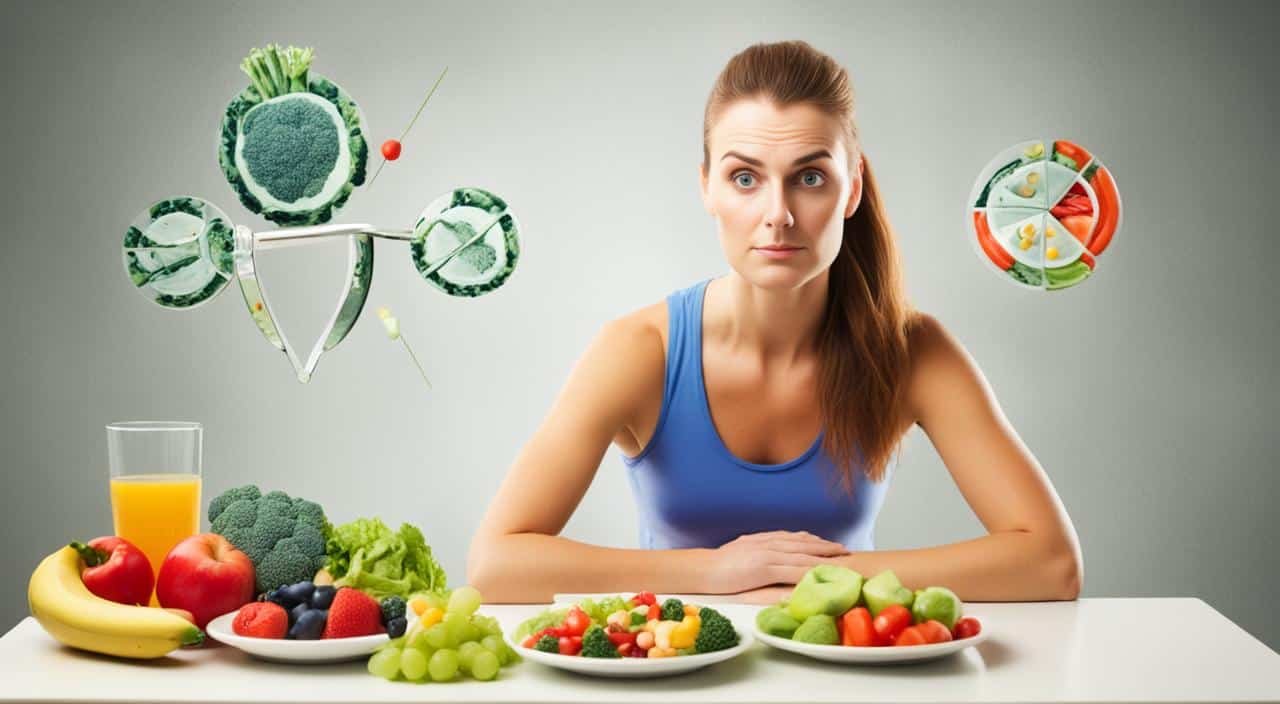Chronic kidney disease (CKD) is a severe condition. It impairs the kidneys’ waste and fluid filtering functions. Changing what you eat is key for managing CKD and keeping your kidneys healthy. The best diet for kidney disease involves eating less salt, watching your protein, picking foods good for your heart, and keeping phosphorus and potassium in check. This special diet slows down the disease and helps avoid complications.
Key Takeaways
- Chronic kidney disease requires a specialized diet to manage the condition and protect kidney health.
- The recommended diet focuses on limiting sodium, managing protein intake, choosing heart-healthy foods, and controlling phosphorus and potassium levels.
- Adhering to this diet can help slow the progression of kidney disease and prevent complications.
- Dietary changes are an essential part of kidney disease management, alongside other treatment strategies.
- Consulting a healthcare professional is crucial for developing a personalized kidney disease diet plan.
Understanding Kidney Disease
Kidney disease is a major health issue affecting kidney function. Several things can cause it. This includes diabetes, high blood pressure, and more. Knowing its symptoms, causes, and effects is key to managing it well.
Symptoms and Causes
When kidney function declines, the body can’t clean out waste and fluids. This leads to issues like fatigue and nausea. Without treatment, it can turn into kidney failure. This might need dialysis or a transplant.
Impact on Kidney Function
Kidney disease affects your overall health and well-being. Healthy kidneys clean your blood by removing waste and extra fluids. But, with kidney disease, this doesn’t work well. Waste and fluids build up.
Not managing it can lead to end-stage renal disease. This is when the kidneys fail completely. At this point, someone might need dialysis or a new kidney to survive.
“Kidney disease can be a silent killer, with symptoms often not appearing until the disease has progressed significantly. That’s why it’s so important to be proactive about monitoring your kidney health.”
Importance of Diet for Kidney Disease
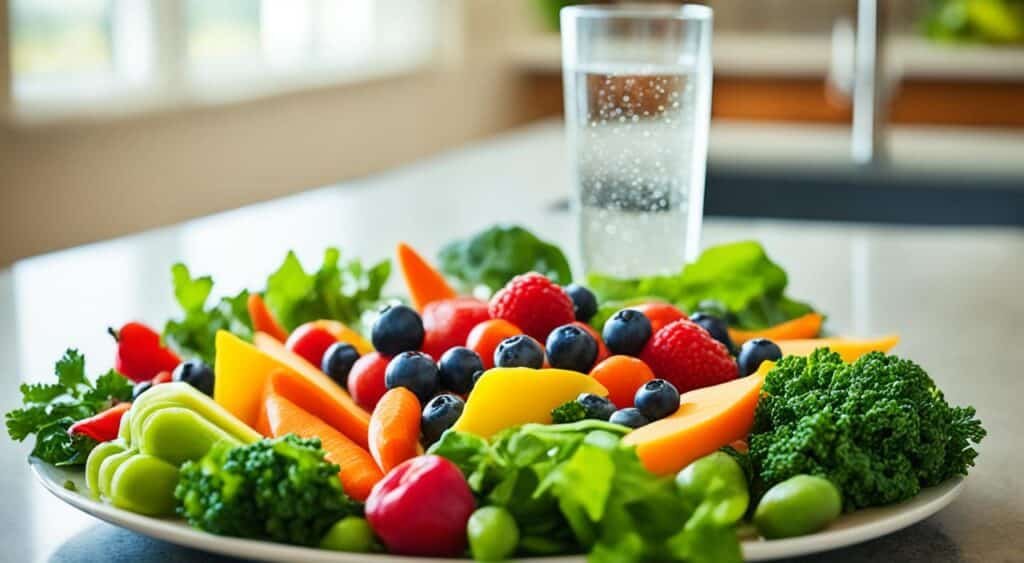
Proper kidney disease nutrition is key to managing and slowing kidney disease. A diet designed for the kidneys can control waste, keep blood pressure and cholesterol levels steady, and protect kidney function. Following these dietary tips can help those with chronic kidney disease stay healthier and lower the risk of problems.
Role of Nutrition in Disease Management
The key dietary recommendations for kidney disease include:
- Limiting sodium intake to help manage blood pressure
- Controlling protein consumption to minimize the buildup of waste products
- Monitoring phosphorus levels to maintain bone health
- Regulating potassium intake to prevent heart and nerve problems
- Choosing heart-healthy foods to support cardiovascular health
Following these guidelines helps people with renal disease manage their kidney health. It slows the condition’s advance. A balanced diet for kidney disease can even keep kidney problems from happening in some people.
“Proper nutrition is essential for managing kidney disease and slowing its progression.”
The right diet and nutrients are crucial for treating and avoiding kidney disease. Working with a healthcare team is important. They help create a diet plan tailored to each person’s needs and supports better kidney function.
Step 1: Reduce Sodium Intake
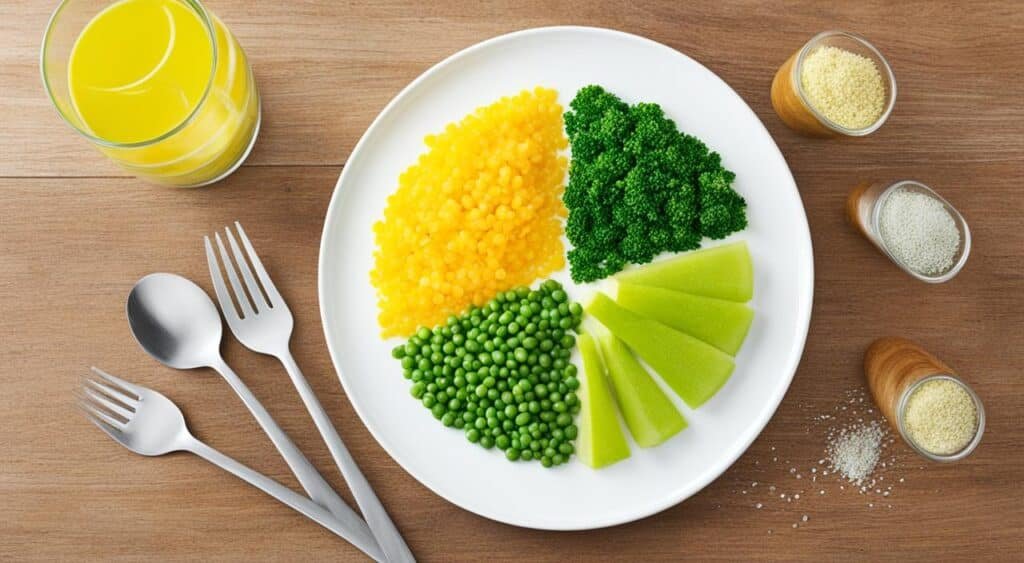
It’s vital to cut down on sodium to manage kidney disease. Stay under 2,300 milligrams a day. Too much sodium can spike blood pressure and stress the kidneys. Avoid processed, canned, and restaurant foods, which usually have lots of salt.
Tips for Lowering Salt and Sodium
Making changes to eat less salt can help your kidneys. Here are simple steps to lower your salt and sodium:
- Cook at home with fresh, whole foods over pre-packaged or canned items.
- Try seasonings without salt, like herbs, spices, and lemon juice, for taste.
- Check food labels and pick low-sodium versions, especially for canned foods and condiments.
- Cut back on processed meats, fast foods, and salty snacks.
- Choose fresh or frozen veggies and fruits—they’re naturally low in salt.
- Don’t add salt to your food while cooking and avoid high-sodium table salt.
With these changes, you can cut down on sodium. This is good for your kidneys. Remember, even small changes help a lot in a low-sodium diet for kidney disease.
“The key to a successful low-sodium diet for kidney disease is to be mindful of the hidden sources of salt in your everyday foods and to make gradual, sustainable changes to your eating habits.”
Step 2: Manage Protein Consumption
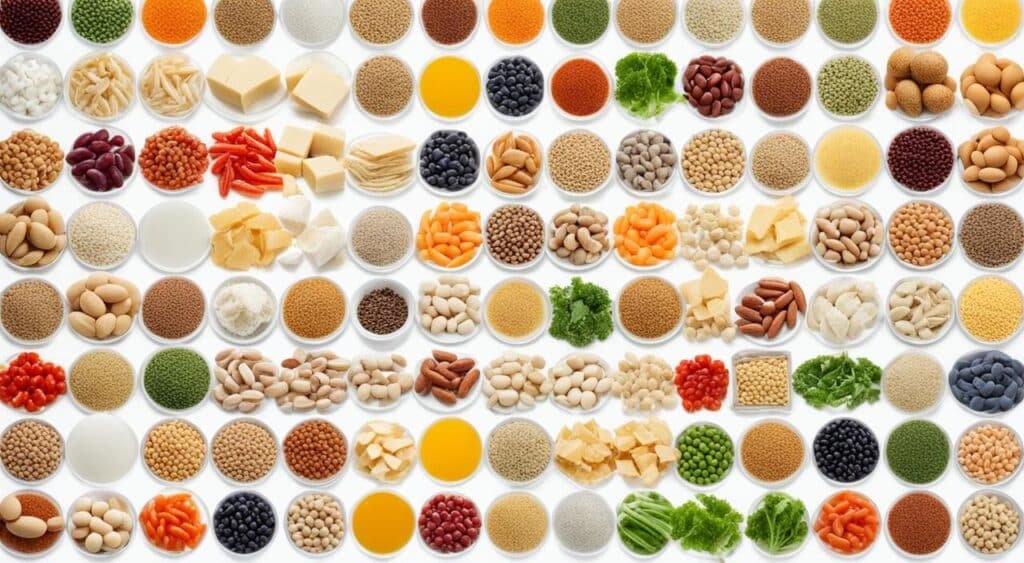
Protein is very important but too much can be bad if you have kidney disease. It can harm your kidneys and slow your recovery. Those with kidney problems should eat only 2-3 ounces of protein with each meal. How much protein you need depends on the stage of your kidney disease.
Sources of Plant and Animal Protein
A mix of plant and animal protein is best for kidney health. Plant sources like beans, nuts, and whole grains are good. They don’t stress the kidneys as much. But you can also eat some animal protein like chicken and fish.
| Protein Source | Protein Content (per serving) |
|---|---|
| Lentils | 18 grams per cup |
| Chicken Breast | 27 grams per 3.5 ounces |
| Quinoa | 8 grams per cup |
| Salmon | 23 grams per 3.5 ounces |
| Almonds | 6 grams per 1 ounce |
Eating different high-protein foods helps you get all you need. This helps to keep your kidneys healthy. But remember, managing how much protein you eat is important for kidney health.
“Striking the right balance between plant-based and animal-based proteins is key for managing kidney disease.”
Step 3: Choose Heart-Healthy Foods
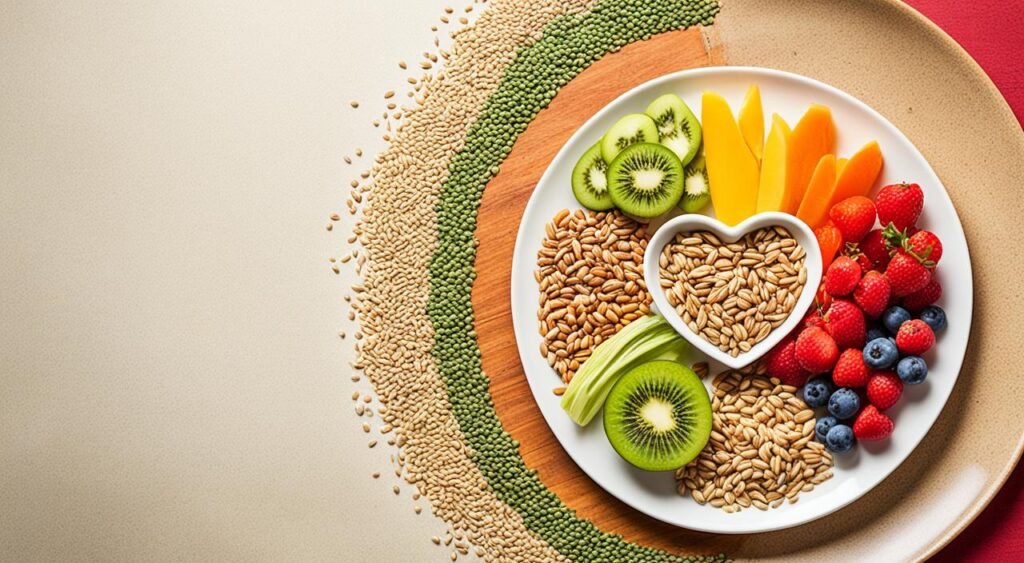
If you have kidney disease, it’s key to eat for your heart. Choose lean meats like grilled chicken and fish. Also, eat plenty of fruits, vegetables, and whole grains. Cut back on saturated and trans fats to lower cholesterol and cardiovascular risk.
Eating for your heart can save your kidneys. A heart-healthy diet lowers the risk of heart problems. It also helps keep your kidneys healthy.
Embrace Lean Protein
Enjoy proteins that are good for your heart and kidneys:
- Grilled or baked chicken
- Fish, especially kinds like salmon and tuna
- Legumes, including beans, lentils, and peas
- Tofu and other soy-based foods
Load Up on Fruits and Vegetables
Make fruits and vegetables a big part of your meals. They’re full of what your body needs, like vitamins, minerals, and fiber. This helps your kidneys and heart stay healthy.
| Fruits | Vegetables |
|---|---|
| Apples | Broccoli |
| Berries | Spinach |
| Oranges | Carrots |
| Bananas | Cauliflower |
Favor Whole Grains
Choose whole-grain foods for a heart-healthy diet. Try things like:
- Brown rice
- Quinoa
- Whole-wheat bread and pasta
- Oats
Whole grains are a good source of fiber and nutrients. They’re right for people with kidney disease trying to eat well for their heart, too.
“A heart-healthy diet is essential for individuals with kidney disease, as it can help protect both the kidneys and the cardiovascular system.”
Step 4: Limit Phosphorus
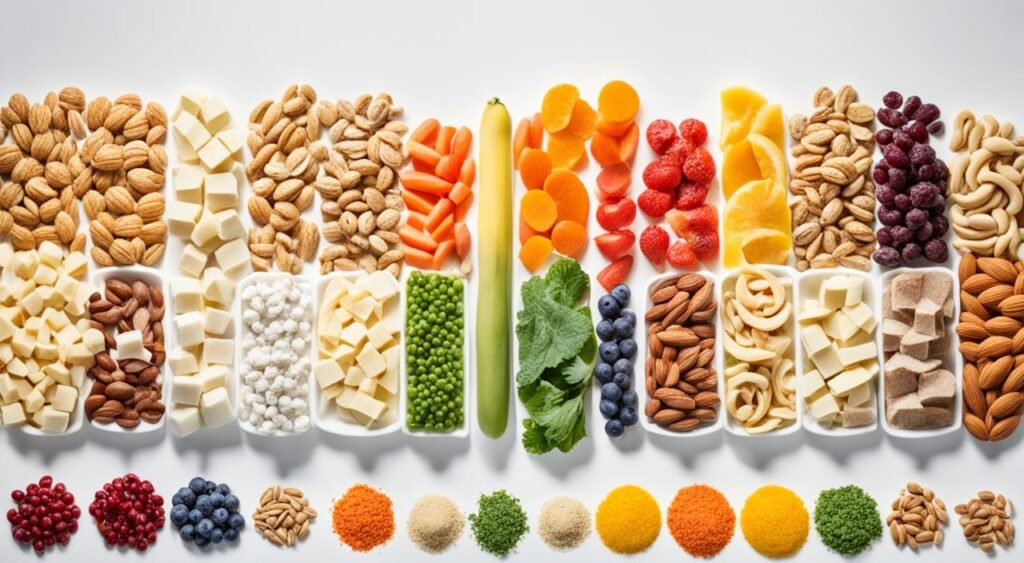
As kidney disease moves on, managing phosphorus gets harder. Too much phosphorus can cause bone and heart issues. To handle this, people with kidney disease need to watch their phosphorus intake. They might also take special drugs called phosphate binders.
Foods High and Low in Phosphorus
It’s important for kidney disease patients to eat less high-phosphorus foods. These foods include:
- Dairy products (e.g., milk, cheese, ice cream)
- Bran cereals and whole-grain breads
- Dark-colored sodas and processed meats
On the other hand, there are foods lower in phosphorus that are safer to eat. They are:
- Fruits (e.g., apples, berries, citrus fruits)
- Vegetables (e.g., broccoli, carrots, leafy greens)
- Lean proteins like chicken, fish, and eggs
Phosphate Binders
Many people with chronic kidney disease might need phosphate binders. These drugs help control phosphorus levels. They stop too much phosphorus from entering the blood. This protects both bone and heart health.
| Phosphorus-Rich Foods | Phosphorus-Poor Foods |
|---|---|
| Dairy products, bran cereals, whole-grain breads, dark-colored sodas, processed meats | Fruits, vegetables, lean proteins like chicken, fish, and eggs |
“By closely monitoring phosphorus levels, kidney disease patients can help protect their bones and cardiovascular health.”
Kidney Disease and Potassium
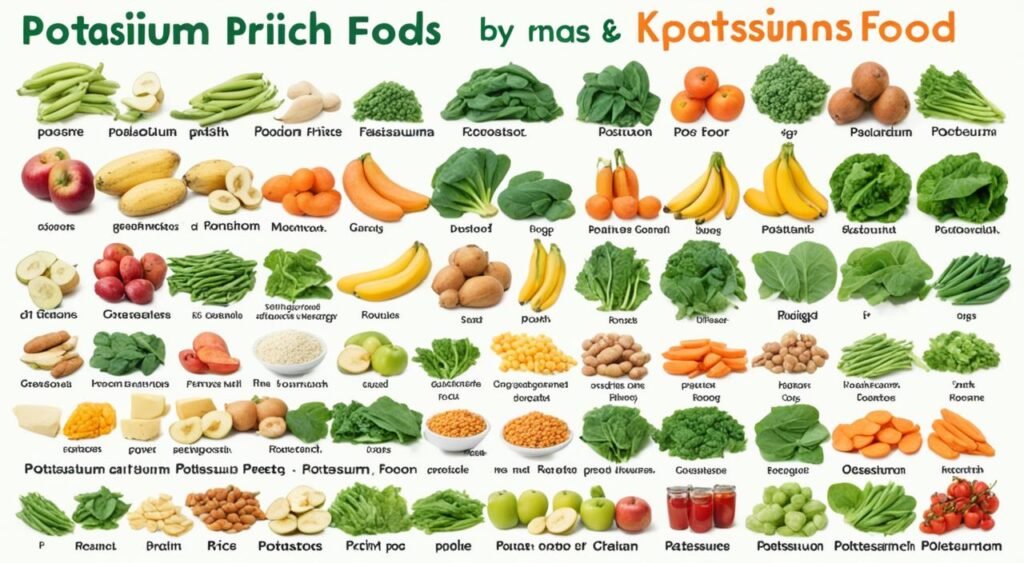
For people with kidney disease, watching their potassium intake is key. If the kidneys can’t remove extra potassium, blood levels might get too high (hyperkalemia) or too low (hypokalemia). This could cause big health problems for their nerve and muscle function.
Patients should eat less of potassium-rich foods and more of potassium-poor foods. This strategy helps keep their potassium levels steady and helps the kidneys work well.
Potassium-Rich and Potassium-Poor Foods
When you have kidney disease, be careful about what you eat. Limit potassium-rich foods like bananas and potatoes to avoid hyperkalemia. Choose potassium-poor foods such as apples and carrots instead.
| Potassium-Rich Foods | Potassium-Poor Foods |
|---|---|
| Bananas | Apples |
| Oranges | Carrots |
| Potatoes | White Bread |
| Tomatoes | Broccoli |
| Spinach | Cauliflower |
Checking potassium levels and adjusting what you eat can keep nerve and muscle function on track. This lowers the chance of hyperkalemia or hypokalemia.
DASH Diet for Kidney Disease
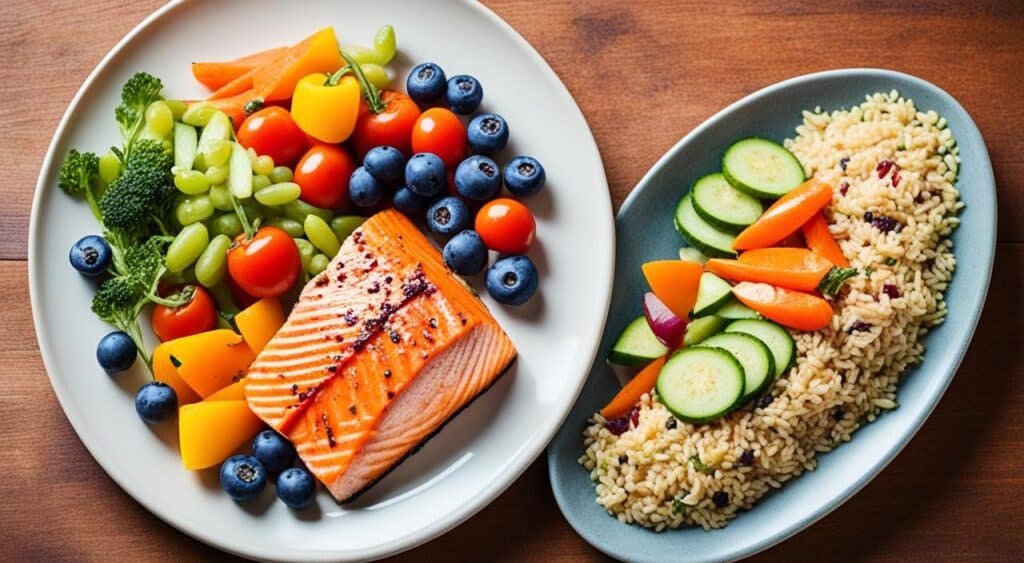
The DASH diet is often advised for people with kidney disease. It’s great for lowering blood pressure. Nutritional guidelines for those with chronic kidney disease (CKD) support this diet. So, it’s very beneficial for CKD patients on their road to better health.
This diet focuses on balancing essential nutrients. It includes plenty of fruits, vegetables, whole grains, lean proteins, and low-fat dairy. These foods help kidney disease patients manage their blood pressure. They can also lower the risk of heart problems and help kidneys work better.
Also Read: Top 10 Cancer Hospitals For Best Treatment
Key Principles of the DASH Diet for Kidney Disease
- Limit sodium intake: Stick to no more than 2,300 milligrams a day. Those with severe kidney disease could need even less.
- Prioritize plant-based proteins: Choose plant-based options like beans, lentils, and nuts. Limit your intake of red and processed meats.
- Focus on heart-healthy fats: Use healthy fats from sources like olive oil, avocado, and nuts. Avoid saturated and trans fats.
- Manage potassium and phosphorus: The DASH diet helps you balance these two key minerals, important for people with CKD.
Following the DASH diet helps kidney patients plan their meals effectively. It’s all about nutrient-dense, whole foods. This approach is a key part of keeping kidney disease from getting worse and staying healthy.
“The DASH diet has been shown to be an effective dietary approach for managing kidney disease, as it helps control blood pressure, reduce the risk of cardiovascular complications, and support overall kidney health.”
Conclusion
Maintaining a kidney-friendly diet is vital if you have chronic kidney disease. It’s key to watch your sodium, protein, phosphorus, and potassium. This helps slow your kidney disease and keeps you well. The DASH diet is a great guide to do this.
Working with a dietitian is smart if you’re dealing with kidney disease. They can help you make a meal plan. This plan will fit your needs and make it easier to stay healthy. To be healthy, choose what you eat wisely and avoid bad foods.
A diet focused on your kidneys is very effective. It helps keep your kidneys working, lowers risks, and boots your health. So, eating right matters a lot to handling your kidney disease.
FAQs
What is the recommended diet for kidney disease?
The best diet for kidney disease involves cutting down on sodium and managing protein. People should eat foods good for the heart. They need to watch their levels of phosphorus and potassium. This diet helps slow down the disease and avoids problems.
What are the main causes of kidney disease?
Kidney disease can come from many things. This includes diabetes and high blood pressure. It can also be caused by certain kidney conditions and frequent UTIs. When the kidneys don’t work well, waste and fluids build up. This can cause tiredness, swelling, and feeling sick.
How does proper nutrition help manage kidney disease?
The right food is key to managing kidney disease. A balanced diet helps stop waste from piling up. It also keeps blood pressure and cholesterol in check. Eating well protects what kidney function is left.
Why is reducing sodium intake important for kidney disease?
Lowering salt is a big deal for kidney disease patients. They should eat under 2,300 mg of sodium per day. Too much salt can make blood pressure high. This puts more stress on the kidneys.
How should protein intake be managed for kidney disease?
Managing protein is crucial for kidney disease. Protein is good but too much can hurt the kidneys. How much protein to eat depends on the kidney disease’s stage.
What are the dietary recommendations for heart-healthy foods in kidney disease?
If you have kidney disease, go for heart-healthy foods. This means choosing lean proteins, fruits, veggies, and whole grains. You should also cut back on bad fats. This lowers your heart risk and helps the kidneys.
Why is controlling phosphorus and potassium intake important for kidney disease?
With less working kidney, the body struggles to handle phosphorus and potassium. Eating too much or too little of these can be risky. So, stick to the right amounts of these minerals to avoid problems.
How does the DASH diet benefit individuals with kidney disease?
The DASH diet is great for kidney disease because it helps control blood pressure. It lowers the chance of heart troubles. Following this diet supports your kidneys’ wellbeing.
Source Links
- https://www.niddk.nih.gov/health-information/kidney-disease/chronic-kidney-disease-ckd/eating-nutrition
- https://www.kidney.org/nutrition/Kidney-Disease-Stages-1-4
- https://www.kidney.org/atoz/content/Dash_Diet
